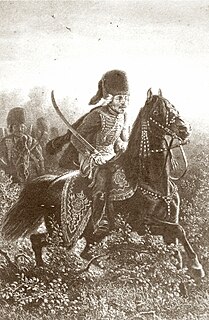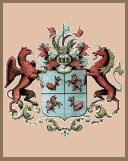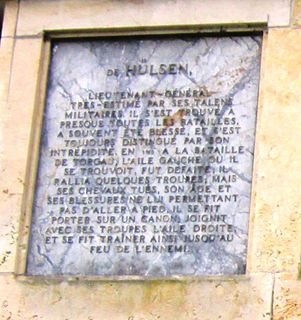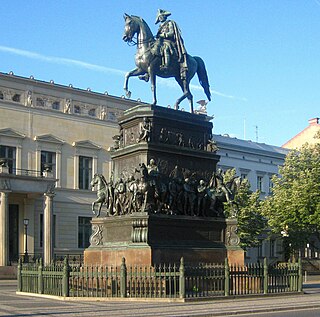
Hans Joachim von Zieten, sometimes spelled Johann Joachim von Ziethen,, also known as Zieten aus dem Busch, was a cavalry general in the Prussian Army. He served in four wars and was instrumental in several victories during the reign of Frederick the Great, most particularly at Hohenfriedberg and Torgau. He is also well known for a raid into the Holy Roman Empire during the Second Silesian War, known as Zieten's Ride. After engaging in a reputed 74 duels, and fighting in four wars, he died in his bed at the age of 86.

The Gardes du Corps was the personal bodyguard of the king of Prussia and, after 1871, of the German emperor. The unit was founded in 1740 by Frederick the Great. Its first commander was Friedrich von Blumenthal, who died unexpectedly in 1745; his brother Hans von Blumenthal, who, with the other officers of the regiment had won the Pour le Mérite in its first action at the battle of Hohenfriedberg, assumed command in 1747. Hans von Blumenthal was badly wounded leading the regiment in a successful cavalry charge in the battle of Lobositz and had to retire from the military.

Knesebeck most often refers to:

Anton Wilhelm von L'Estocq was a Prussian cavalry general best known for his command of the Prussian troops at the Battle of Eylau.

Friedrich Wilhelm, Count of Brandenburg was a German soldier and politician, who served as Minister President of Prussia from 1848 until his death.
Karl von der Gröben was a Prussian general.

Ludwig Johann Karl Gregor Eusebius Freiherr Roth von Schreckenstein was a Prussian General of the cavalry and Minister of War.

Friedrich August Eberhard, Prince of Württemberg was a royal Prussian Colonel General of the Cavalry with the rank of Generalfeldmarschall and Kommandierender General of the Guards Corps for more than 20 years. August was a member of the House of Württemberg and a Prince of Württemberg by birth.
Alexis Carl Ernst Louis Ferdinand Eugen Bernhard, Prince of Bentheim and Steinfurt was a Lieutenant General, statesman, and the Prince of Bentheim and Steinfurt from 28 September 1890 to 21 January 1919.

Johann Jakob von Wunsch (1717–1788) was soldier of fortune and Prussian general of infantry, and a particularly adept commander of light infantry. The son of a Württemberg furrier, he served in several armies in the course of his lengthy career.

Joachim Bernhardt von Prittwitz and Gaffron (1726–1793), born in Groß Läswitz, died in Berlin, was a Prussian officer credited with saving the life of Frederick the Great at the Battle of Kunersdorf. At the time, he was a cavalry captain in Hans Joachim von Zieten's Hussar regiment. He became the head of gendarmes regiment, and inspector general of the cavalry of Brandenburg March and Magdeburg in 1775. He was promoted to lieutenant general in 1785 and general of cavalry in 1788. Frederick awarded him the Order Pour le Mérite and the Order of the Black Eagle. In 1851, Prittwitz was included on the panels of the Equestrian statue of Frederick the Great as one of the key figures in the establishment of the Prussia state.

Johann Dietrich von Hülsen was a Prussian lieutenant general of the infantry. After a lifelong officer's career in various infantry regiments, he acquired the special respect of Frederick II in the Seven Years' War as general, and was honored by him with the appointment as governor of Berlin. During the war, he became a canon to Minden and was awarded the Black Eagle Order and the Order Pour le Mérite. His name appears on the top tier of the Equestrian statue of Frederick the Great.

Dubislav Friedrich von Platen was a Prussian officer in Frederick the Great's army. A cavalry general, he was also Governor of Königsberg, a Knight of the Order of Saint John, and a recipient of the Order of the Black Eagle. An active cavalry officer in all of the wars fought by Frederick—the War of Austrian Succession, the Second Silesian War, the Seven Years' War and, finally, the War of Bavarian Succession—he was memorialized on Equestrian statue of Frederick the Great in 1851 erected by Frederick's great-great nephew, Frederick William IV.
Moritz Franz Kasimir von Wobersnow was a Prussian major general of infantry and a general adjutant of Frederick the Great. He died at the Battle of Kay; a lifelong friend of the King, his name is included on the Equestrian statue of Frederick the Great.
Heinrich Gottlob von Braun was a Prussian general of infantry. He served Frederick the Great during the War of Austrian Succession, and received the Order Pour le Mérite and the Black Eagle Order. In 1851, he was also memorialized on the Equestrian statue of Frederick the Great.

Robert Scipio, Freiherr von Lentulus was a military officer, first in Austrian service, later in Prussian service. He was among Frederick the Great's trusted officers, and served him not only in military capacity but as a diplomat and, later, a governor of Neuchâtel. He was proprietor of a Prussian cavalry regiment in the years 1758–1778.

Peter Ernst von Pennavaire ], was the son a French advocate (attorney) in Toulouse, who had fled from France in about 1685. He served in Prussian army, achieving the rank of lieutenant general of cavalry and proprietor of the Leib-Carabiniers. He was the recipient of both the Black Eagle Order and Pour le Mérite. At the Battle of Breslau, when he was 80 years old, he led his cavalry in a charge at the Austrian front. He died of complications from injuries received at the Battle.

Karl Friedrich von Moller was a Prussian colonel of artillery. His uncanny genius at setting up artillery parks gave Frederick the Great high confidence in the artillery's ability to effect the outcome. During the Seven Years' War, Moller gained great fame specifically for his actions at Lobositz, Rossbach and Zorndorf.

Joachim Friedrich von Stutterheim („Alt-Stutterheim“),. He was known as the Old Stutterheim to distinguish him from his younger brother, Otto Ludwig (1718–1780), also a lieutenant general in Frederick the Great's army.
Charles Emanuel de Warnery was a royal Prussian colonel, later a royal Polish general. He was born 13 March 1720 at Morges on the Lake Geneva, Canton Vaud and entered served in the Sardinian service on the Regiment Desportes, and participated in the Upper Italy campaign against Austria during the War of Polish Succession. He briefly served in the Russian army during the Russo Swedish War. In 1743, he joined the Prussian army and served in the War of Austrian Succession and the Seven Years' War. Upon his retirement in 1758, he entered a second career in military writing, developing commentaries on military tactics, particularly those of mounted troops, from the time of the Caesars to Frederick the Great.
























